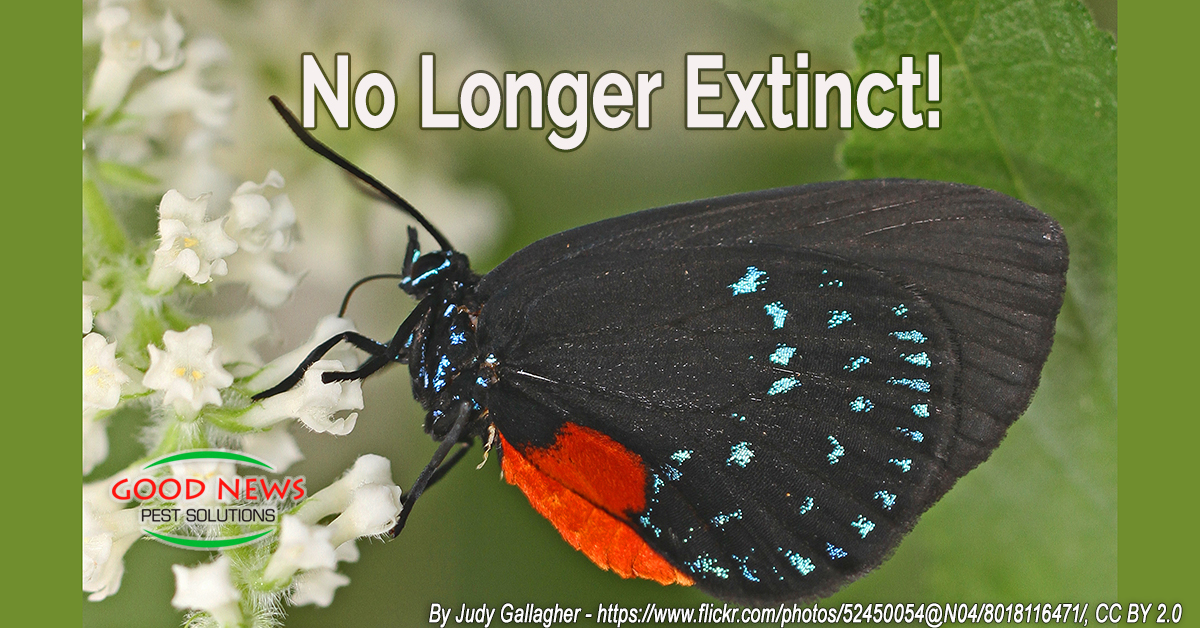
No Longer Extinct!
For more than 20 years the Atala butterfly was thought to be extinct. In 1959, hope was resurrected when a Eumaeus atala Poey, the largest and most iridescent hairstreak butterfly, was once again spotted in southern Miami.
The Atala butterfly is considered a “Species of Greatest Conservation Need” – not extinct, but on the verge, and it can be months or years between significant sightings. In the late 80’s, the Atala butterfly had vanished from the Florida Everglades. Efforts were made to reintroduce the Atala into the park around Long Pine Key from 2004 to 2008, but seemed to be for naught.
There was no evidence that the transplanted butterflies had survived.
Eumaeus Atala
The Atala butterfly exists almost exclusively in South Florida and the Caribbean islands, although at least one popped up in recent years in Virginia.
Like a few other butterflies, the Atala are very picky about their food source and locations to lay their eggs. For the Eumaeus atala, that host plant is the Coontie. Between the early Americans venturing down the Gulf coast and the post Great War carpet baggers, the Coontie was heavily harvested for its starch, leaving the butterflies in a precarious position.
When folded together (as in the picture above), the outside of an Atala’s wings are deep black with curved rows of iridescent blue spots. The caterpillars have a bright red-orange abdomen with yellow spots that the butterflies carry with them when they emerge from their chrysalises.
An interesting note: hairstreak butterflies pupate in a crescent, rather than the elongated J shape we’re used to seeing from most butterflies.
A few days after emerging, they pair up and shortly thereafter lay their eggs – complete with spikey scales that stick to the eggs as the adult butterfly lays them. They will lay eggs on Zamia pumila or Coontie plants.
A Remarkable Discovery
While the butterflies seeded into Everglades National Park did not seem to take, at least a few must have. Last month, Atala hairstreak caterpillars were spotted – not in the park, but outside the park’s visitor center!
Atala butterflies live up to three weeks in the wild but can survive much longer – up to three months – when supplied with the ideal nectar and host plants.
The comeback of the Coontie plant – also only native to our subtropical shores – has been a struggle, thanks to chemical pesticides and fertilizers. But the growing use of the drought- resistant cycad plant, that looks like a spiny evergreen fern, as a native landscaping feature has helped it spread. Bringing with it, of course, the all-but-gone butterfly.
Coontie plants are on the official Xeriscape list, meaning they are suitable for native landscaping credits if they’re available in your area. Entomologists at the University of Florida say you can help the Atala butterflies by planting more Coontie plants and maintaining them with organic fertilizer and natural pest control.
Good News Pest Solutions uses nothing but the greenest, most environmentally friendly solutions for insect abatement. We’ve served customers for more than 35 years with solutions like our Go Green Perimeter Plus. All the insect coverage you need, none of the harsh chemicals you and your plants don’t.
For more details on the program or to schedule your first appointment, just give us a call!
« Back to Blog
Proudly Serving
Sun City Center, Ruskin, Palmetto, Parrish, Ellenton, Bradenton, Anna Maria, Holmes Beach, Bradenton Beach, Longboat Key, Lakewood Ranch, University Park, Myakka City, Sarasota, Siesta Key, Osprey, Nokomis, Casey Key, Venice, Englewood, North Port, Port Charlotte, Punta Gorda, Arcadia
Things You Can Do
Pay Your Bill Online
Leave Us a Review
Request a Free* Termite Inspection
Stop Mosquito Bites
Get Rid of Rodents
Get a Termite Damage Warranty
Get Pest Control for Your Attic
Get Pest Control for Your Business Request Prayer
Corporate Address
1080 Enterprise Court, Ste A
North Venice, FL 34275
Call Now: (941) 412-9610
Text: (941) 412-9610
Fax: (941) 412-0080
